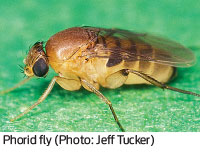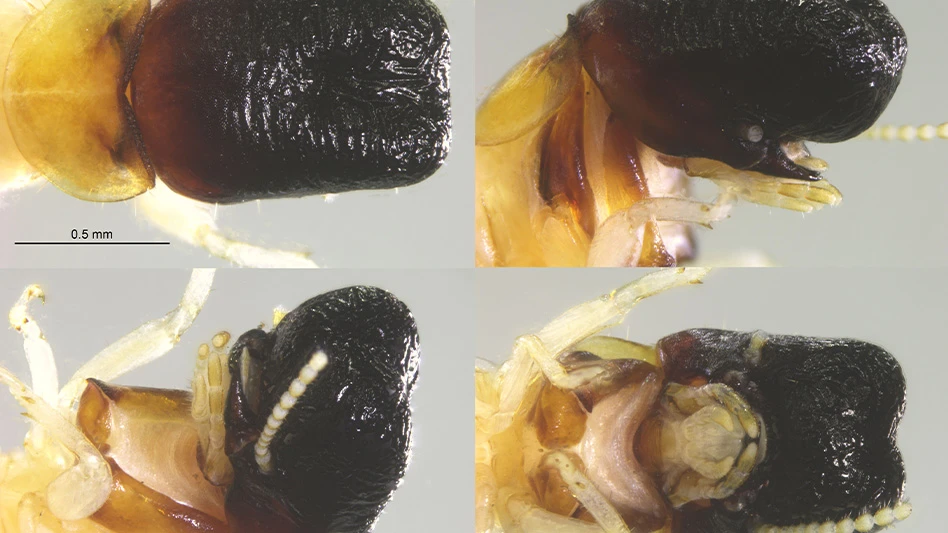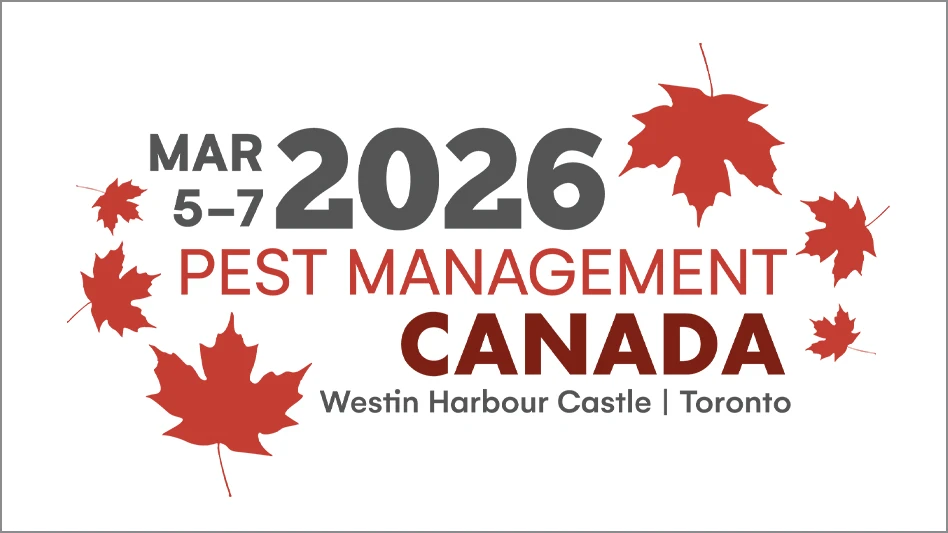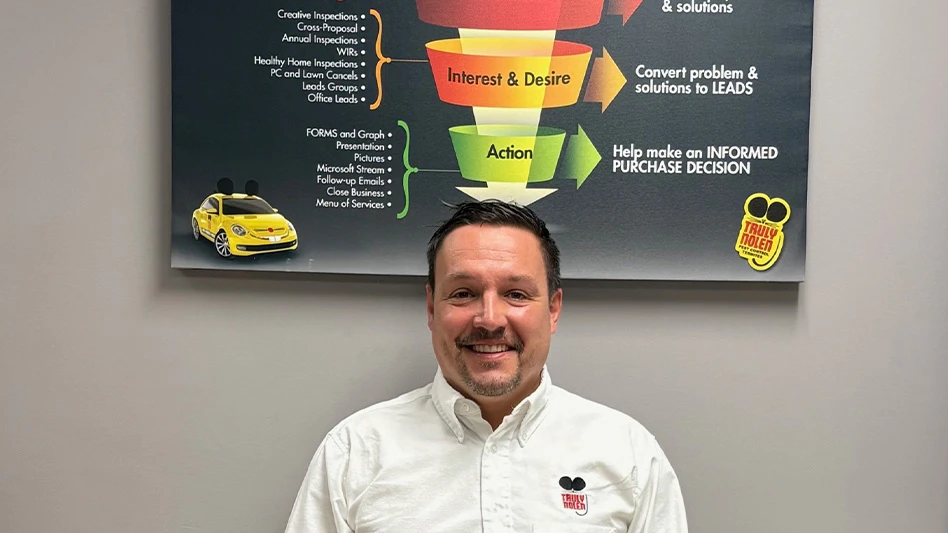 They can run, they can hide, and when they’re found, they are often misidentified. They are phorid flies, and, although they are not the most common pests, they are highly intractable and can be an expensive problem for any home or business owner. That’s why, at NPMA PestWorld 2012, Mark “Shep” Sheperdigian of Rose Pest Solutions, Richard Berman of Waltham Services and Jay Bruesch of Plunkett’s Pest Control teamed up to share their insights into how to properly identify and effectively manage the phorid fly.
They can run, they can hide, and when they’re found, they are often misidentified. They are phorid flies, and, although they are not the most common pests, they are highly intractable and can be an expensive problem for any home or business owner. That’s why, at NPMA PestWorld 2012, Mark “Shep” Sheperdigian of Rose Pest Solutions, Richard Berman of Waltham Services and Jay Bruesch of Plunkett’s Pest Control teamed up to share their insights into how to properly identify and effectively manage the phorid fly.
Identification. Misidentification is one of the main reasons why many pest technicians are unable to successfully treat for phorid flies. According to Sheperdigian, the phorid fly is “Usually accused of being Drosophila or some other fruit fly, which leads to control methods which are less than optimal, which leads to weeks or months or years of ineffective control,” he said. To avoid misidentification, technicians should be aware of the characteristics that are most common among the phorid fly.
Physically, there are three traits that make the phorid stand out. First, phorids are known for their hunched back, which has earned them the name “humpback” fly. This trait, however, is not enough to definitively classify a specimen as a phorid since not all phorids have the humpback and a few non-phorids also share this characteristic.
Instead, says Sheperdigian, technicians often identify the phorid by its unique wing venation. “When you see a phorid wing, you will note that the first few veins are very thick or heavily sclerotized. The rest of the veins are very light and don’t seem to attach to anything. With very few exceptions, there are no cross-veins on phorid wings,” he said.
Lastly, since not all phorids have the humpback and since tight, thick wing veins are common in other pests, the third indicator of the adult phorid is its enlarged second antennal segment. “If you’ve got the wing venation and an antennal segment like that, you’ve got a phorid,” said Sheperdigian. A similar indicator is visible in the phorid pupae, which usually have unique respiratory horns that form during the end of the first stage of pupation.
Behaviorally, Sheperdigian also pinpoints three traits to help any pest technician identify a phorid in the field. First, most phorids flies live deep underground. “The pest species of phorids need [a] moist environment and will dry out very quickly…if you see phorids as pests, they’re coming from somewhere very wet and very icky,” said Sheperdigian.
Because most phorids live underground, adults are known for their penetration skills. In order to get to and from that moist environment, they are able to burrow deep underground through cracks and crevices. As a result, most adult phorids are also light-attracted and will often be found in light traps.
Finally, the phorid has earned the name “scuttle fly” because of its most common behavioral identifier: the fly runs, usually in a jerky zig-zag motion, rather than flies. “Usually, you’re in a situation where you’d expect them anyway,” said Sheperdigian, “So, when you see that, it’s a great field character to help you identify the fly.”
Sheperdigian cautions, however, that the phorid is a diverse family made up of a variety of species that may not all have the same characteristics. Even the phorid lifecycle can vary significantly based on temperature, food quality, environment and species. “We’re used to the Drosophila who can blow through their lifecycle in seven days in optimal condition. The thing about phorid flies is that if [they’re] living under the ground, those are not optimal conditions,” said Sheperdigian. As a result, their lifecycle is protracted and it may take six to eight weeks for the phorid to go from egg to adult.
Inspection Techniques. A good grasp on the physical and behavioral characteristics of the phorid fly is essential to the inspection process. “How we can use that [knowledge] to our advantage...is a principle that governs everything that we do,” said Berman. Training and on-the-job experience, however, is vital for transforming this knowledge into successful practice.
Since adult phorids are attracted to light, light and glue traps near windows and cracks can help technicians collect an initial sample of the pest to confirm whether it is or is not a phorid fly. The best time for an inspection is early morning, explained Bruesch, “because the adults will tend to disperse and, during the day time, they will go to the brightest windows [but] flies will tend, in the morning, to be over their sources, over their larvae.” This source, however, may not be visible at surface level.
 “Phorid flies require material that is completely putrid … if you have phorid flies in a place, whether you can see it or not, there is something putrid,” said Bruesch. He cautions, however, that technicians need to be wary of blaming the flies on any visible mess. Since, in some situations, phorids may spend most of their life cycle underground or beneath floors, “[The source is where] you find larvae and when your nose detects that scent of putrescence,” he said.
“Phorid flies require material that is completely putrid … if you have phorid flies in a place, whether you can see it or not, there is something putrid,” said Bruesch. He cautions, however, that technicians need to be wary of blaming the flies on any visible mess. Since, in some situations, phorids may spend most of their life cycle underground or beneath floors, “[The source is where] you find larvae and when your nose detects that scent of putrescence,” he said.
If phorid adults are found or if the technician suspects the conditions meet the phorid’s environment, Berman often recommends that clients dig up their floor to give his technicians access to the suspected source. This recommendation is often met with resistance, however, which is why he suggests technicians begin by covering breeding sources and drilling pilot holes in the floor. Putting plastic wrap on potential breeding areas such as toilets and open drains will work as a trap for any phorids using that source. Pilot holes drilled into the floor over the suspected source areas and covered with clear plastic cups or containers will also show whether phorids are living beneath the floor.
Whenever using these techniques, it’s important for technicians to use transparent plastic wrap or containers in order to ensure that light can still penetrate in order to attract the flies. One inspection tool that Berman cautions technicians about using is the cable-mounted camera. “You need to be cautious because they can only go in at certain points and they can only see certain spots…cameras can frequently find stuff, but they’re very limited,” he said. These inspection techniques are not treatments, but, if the flies are found, these tests can help convince the customer to take the necessary next steps in the treatment process.
Tough Treatment. Due to the nature of the phorid fly, treatment can be one of the most difficult parts of the process because it often requires customer buy-in and costs above and beyond traditional pest management solutions. “[The customer’s] role in solving the problem can involve digging up a floor, repairing or fixing plumbing, removing soil…it takes a lot of effort and commitment to do that, and those types of fixes are not inexpensive,” said Berman. As a result, many customers resist actively treating the problem because it is too expensive or invasive.
In some instances, the treatment of the source will not be possible. Berman recalls a customer who refused to dig up the flooring or move counters in order to allow his technicians to treat the source of the problem. Instead, they had to apply treatment and sealant to the cracks through which the phorids were emerging and have the property manager fix the leaking pipes that were supplying the right conditions for the phorid source. “It wasn’t the perfect solution, but…the bottom line was that they were satisfied,” he said.
Bruesch also suggests that when customers are unwilling or unable to perform the extensive work needed for a permanent solution, the pest management company should make a record for both companies’ files stating the level of the problem and the suggested treatments so that the pest management company or technician is not held accountable should the infestation return or continue.
When customers are willing to treat for phorid flies, the process usually involves opening up the floor, replacing any broken or leaking pipes, digging out infested soil and replacing it with fresh, treated soil, and then resealing the floor and any other cracks or entryways. In one nursing home that Berman treated, the cost of the total repairs was around $25,000 while the cost for the targeted pest treatment was less than $1,000. “They had some serious maintenance and repair work to do. No amount of insecticide or application work is going to solve that problem,” he said.
The author is a PCT contributing writer and can be contacted at kmannes@giemedia.com.

Explore the June 2013 Issue
Check out more from this issue and find your next story to read.
Latest from Pest Control Technology
- Donny Oswalt Shares What Makes Termites a 'Tricky' Pest
- Study Finds Fecal Tests Can Reveal Active Termite Infestations
- Peachtree Pest Control Partners with Local Nonprofits to Fight Food Insecurity
- Allergy Technologies, PHA Expand ATAHC Complete Program to Protect 8,500 Homes
- Housecall Pro Hosts '25 Winter Summit Featuring Mike Rowe
- Advanced Education
- Spotted Lanternflies, BMSBs Most Problematic Invasive Pests, Poll Finds
- Ecolab Acquires Guardian Pest Solutions





